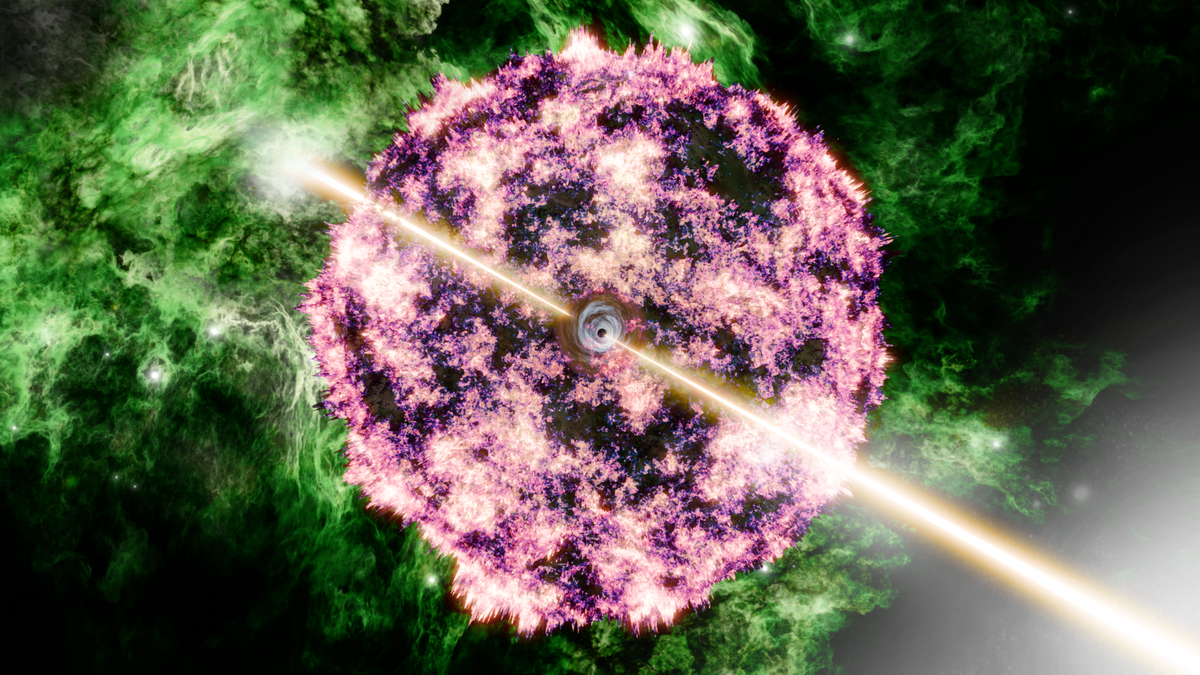In October 2022, an extremely bright flash caught the attention of the Gemini South telescope in Chile. It quickly became clear that it was meant to be the brightest everhence his nickname: the brightest of all time (the BOAT).
Now a group of researchers has studied the event using the Webb Space Telescope and concluded that the cause of the BOAT was a supernova: an explosive and radiant death of a star. Researchers also looked for heavy elements such as gold and platinum, but saw no signs of them, leaving the question of their origin still open. The team’s research is published today in natural astronomy.
Heavy elements are created by the merger of neutron stars – at least some of them. The heavy stuff in the universe is too numerous for such star mergers to explain all of them. Even if two stars in a binary star system explode, leaving the dense shells of neutron stars behind, “it can take billions and billions of years for the two neutron stars to slowly come closer and closer together and eventually merge,” said Peter Blanchard, an astronomer at Northwestern University and lead author of the study at the university release.
“However, observations of very old stars suggest that parts of the universe were enriched in heavy metals before most binary neutron stars had time to merge,” Blanchard added. “That points us to an alternative channel.”
Gamma ray bursts come in two varieties: long and short. Short bursts are associated with star mergers and black hole formation. according to NASA, while the longer bursts are associated with the death of stars. The BOAT clearly falls into the latter camp.
The team intentionally waited several months after discovering the BOAT to point the Webb telescope at it. That’s because the explosion was so bright – and that brightness lasted so long – that they had to wait until the event faded to detect signs of the supernova that produced it.
Using the telescope’s near-infrared spectrograph (NIRSpec), the team studied the elements typically found in supernovae. The signal wasn’t particularly bright, suggesting that the supernova that produced the brightest gamma-ray burst ever seen wasn’t itself superlative.
“This event is particularly exciting because some had hypothesized that a bright gamma-ray burst like the BOAT could produce many heavy elements such as gold and platinum,” said study co-author Ashley Villar, an astrophysicist at Harvard University and the Center for Astrophysics | Harvard & Smithsonian, in the press release. “If they were right, the BOAT should have been a gold mine. It’s really striking that we haven’t seen any evidence of these heavy elements.”
Long gamma ray bursts are those that last longer than two seconds. The BOAT lasted an incredible 10 hours, according to ScienceNews. But if we are technical then It’s not BOAT Strictly speaking the boat. However, according to Eric Burns, an astrophysicist at Louisiana State University and co-author of a, it is “probably the brightest X-ray and gamma-ray burst since the beginning of human civilization.” study Description of the signal.
A year and month after the signal, a scientific collaboration found that the BOAT was emitting gamma rays with energy reaches up to 13 teraelectron volts– the same energy as CERN’s Large Hadron Collider in the second round.
Scientists continue to comb through the treasure trove of data provided by the BOAT. Last June a group reported on it the structure of the jet of the eruption, which could lead physicists to revise their models of the jet structure. Despite all the accolades, the BOAT is not the largest explosion ever observed in space; That title belongs to AT2021lwx, a nearly 8 billion-year-old eruption of a distant black hole and its surrounding gas cloud.
Astronomers will likely see more explosions like this – and like the BOAT – as next-generation observatories come online. One of the most hyped facilities is the Vera Rubin Observatory in Chile’s Atacama Desert, which will use one 3.2 billion pixel camera to collect terabytes of data about the southern sky every night.
More: The world’s largest digital camera is finally finished
